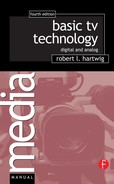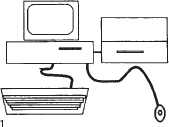Nonlinear editing allows greater flexibility and creativity.
Nonlinear Editing
The advent of digital video and of new, more powerful small computers has brought about what is called nonlinear editing. This allows the editor to go back and change or modify individual scenes at any time without the need to reedit the entire tape from that point on.
The process can vary a little. With some formats the digital video can be transferred directly from the recorder to the editor. Analog videotape will have to be digitized and stored in a digital memory. Some digital tape formats will also have to be dubbed to the editor in real time.
Using a powerful computer with specialized programming, the editor can call up individual shots and scenes from that memory. As the editor views the material, he or she can decide how long each shot should be and in what order the shots should be played back. When playing back an edited scene, the computer calls up the first shot chosen from its memory and displays the selected segment. It then calls up the next shot selected and displays it, and so on. What the editor is actually seeing is selected segments of the computer memory displayed one after the other in a continuous manner. This will appear as a single uninterrupted scene. The editor can put together the entire program in this way. If the editor wants to change a scene, he or she just goes back to that portion of the playback and makes whatever additions or cuts are desired. When playing back the changed sequence, the computer will include the changes and play back the subsequent scene at the proper time.
In this way, the editor can do a “rough cut” of the entire show and then go back and fine-tune or polish the rough spots without having to reedit the entire segment. Once the editor is satisfied with the show, the edit decision list can be put together for the on-line editing of the show.
Since some videotape formats require that the video be digitized and stored in a digital memory, there is an added step that requires some time that is not necessary using a video server or other disc-based sources. Once the video is in memory, however, greater creativity and flexibility are possible. Nonlinear editing has almost completely replaced traditional linear tape editing.

1. Personal computer-based off-line nonlinear editing station.
2. Flexibility of nonlinear editing.

